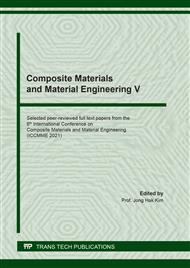[1]
Setua DK, Pandey KN, Saxena AK, Mathur GN, Characterization of elastomer blend and compatibility, J Appl Polym Sci, 74, 480-489, (1999).
DOI: 10.1002/(sici)1097-4628(19991017)74:3<480::aid-app2>3.0.co;2-b
Google Scholar
[2]
Nakason C, Kaesaman A, Samoh Z, Homsin S, Kiatkamjornwong S, Rheological properties of maleated natural rubber and natural rubber blends, Polym Test, 21, 449-455, (2002).
DOI: 10.1016/s0142-9418(01)00109-x
Google Scholar
[3]
Pomposo JA, Calahorra E, Eguiazabal I, Cortazar M, Miscibility behavior of ternary poly (methylmethacrylate)/poly (ethylmethacrylate)/poly (p- vinylphenol) blends, Macromolecules, 26, 2104- 2110, (1993).
DOI: 10.1021/ma00060a045
Google Scholar
[4]
Ismail H, Leong HC, Curing characteristics and mechanical properties of natural rubber/chloro- prene rubber and epoxidized natural rubber/chloroprene rubber blends, Polym Test, 20, 509-516, (2001).
DOI: 10.1016/s0142-9418(00)00067-2
Google Scholar
[5]
Pandey KN, Setua DK, Mathur GN, Determination of the compatibility of NBR/EPDM blends by an ultrasonic technique, modulated DSC, dynamic mechanical analysis, and atomic force microscopy, Polym Eng Sci, 45, 1265-1276, (2005).
DOI: 10.1002/pen.20396
Google Scholar
[6]
G.C. Basak, A. Bandopadhyay, Y.K. Bharadwaj, S. Sabharwal, A.K. Bhowmick, Adhesion of vulcanized rubber surfaces: characterization of unmodified and electron beam modified EPDM surfaces and their co-vulcanization with natural rubber, J. Adhes. Sci. Technol, 23 1763-1786, (2009).
DOI: 10.1163/016942409x12489445844471
Google Scholar
[7]
M. Ehsani, H. Borsi, E. Gockenbach, J. Morshedian, and G. R. Bakhshandeh, An investigation of dynamic mechanical, thermal and electrical properties of housing materials for outdoor polymeric insulators, The European Polymer Journal, vol. 40 (11), 2495–2503, (2004).
DOI: 10.1016/j.eurpolymj.2004.03.014
Google Scholar
[8]
E. Meuleman, J. Willemsen, M. Mulder, and M. Strathmann, EPDM as a selective membrane material in pervaporation, Journal of Membrane Science, vol. 188 (2), p.235–249, (2001).
DOI: 10.1016/s0376-7388(01)00382-9
Google Scholar
[9]
J.R. White, S.K.De, Ruber Technologist's Handbook, Rapra Technology LTD. (2001).
Google Scholar
[10]
Zhenhua Wang Yonglai Lu Jun Liu Zhimin Dang Liqun Zhang, Preparation of nano zinc oxide/EPDM composites with both good thermal conductivity and mechanical properties, J. of applied polymer science, 119 (2), 1144-1155, (2011).
DOI: 10.1002/app.32736
Google Scholar
[11]
Martin van Duin Ramona Orza Ron Peters Victor Chechik, Mechanism of Peroxide CrossLinking of EPDM Rubber, Macromolecular Symposia, Vol. 292 (1), 66-74, (2010).
DOI: 10.1002/masy.201050508
Google Scholar
[12]
Suma, N.; Joseph R.; and George, K. E., Improved mechanical properties of NR/EPDM and NR/ butyl blends by precuring EPDM and butyl, J. Appl. Polym. Sci., 49, 549 – 556, (2003).
DOI: 10.1002/app.1993.070490318
Google Scholar
[13]
Botros, S. H. and Sayed, A. M., Swelling behavior of NR/EPDM rubber blends under compression strain, J. Appl. Polym. Sci., 82, 3052 - 3066, (2001).
DOI: 10.1002/app.2160
Google Scholar
[14]
Tapan K. et al, Abrasion of high temperature conveyor belt compounds based on ethylene propylene diene and bromobutyl rubber blends, Wear, Vol. 128, 167 – 178, (1988).
DOI: 10.1016/0043-1648(88)90182-2
Google Scholar
[15]
Handbook of Belting, Goodyear Tire and Rubber Company, (1953).
Google Scholar
[16]
Brendan Rodgers, Rubber Conveyor Belt Technology, Kindle edition, (2020).
Google Scholar
[17]
Payam Zahedi, Rubber Adhesion to Different Substrates and Its Importance in Industrial Applications: A Review, Journal of Adhesion Science and Technology, Vol. 26, 721-744, (2012).
DOI: 10.1163/016942411x579975
Google Scholar
[18]
Ningning Gong et al. Effect of metal surface state on injection joining strength of aluminum-rubber composite part, Journal of Manufacturing Processes, vol. 49, 365-372, (2020).
DOI: 10.1016/j.jmapro.2019.12.006
Google Scholar
[19]
Gyung Soo Jeon et al., Enhancing the Adhesion Retention by Controlling the Structure of the Adhesion Interphase Between Rubber Compound and Metal. Part I. Effect of Cobalt Salt. Journal of Adhesion Science and Technology, Vol. 23, 913 – 930, (2009).
DOI: 10.1163/156856109x411256
Google Scholar
[20]
Atanu Banerjee et al. Effect of Sn on the Adhesion between Cu–Sn Alloy Coated Steel and Styrene Butadiene Based Rubber, ISIJ International, Vo. 54 (3), 671-676, (2014).
DOI: 10.2355/isijinternational.54.671
Google Scholar
[21]
I. Ismail, M. K. Harun, Adhesion failure of rubber/metal composite undergoing corrosion, Rubber Chemistry and Technology, 90 (3), 455- 466, (2017).
DOI: 10.5254/rct.16.83764
Google Scholar
[22]
N.A. Nikiforova, M.A. Sheryshev, Estimation of the adhesion strength of rubber-metal bonds, Polymer Science, Vol. 5, 53-59, (2012).
DOI: 10.1134/s199542121201011x
Google Scholar


